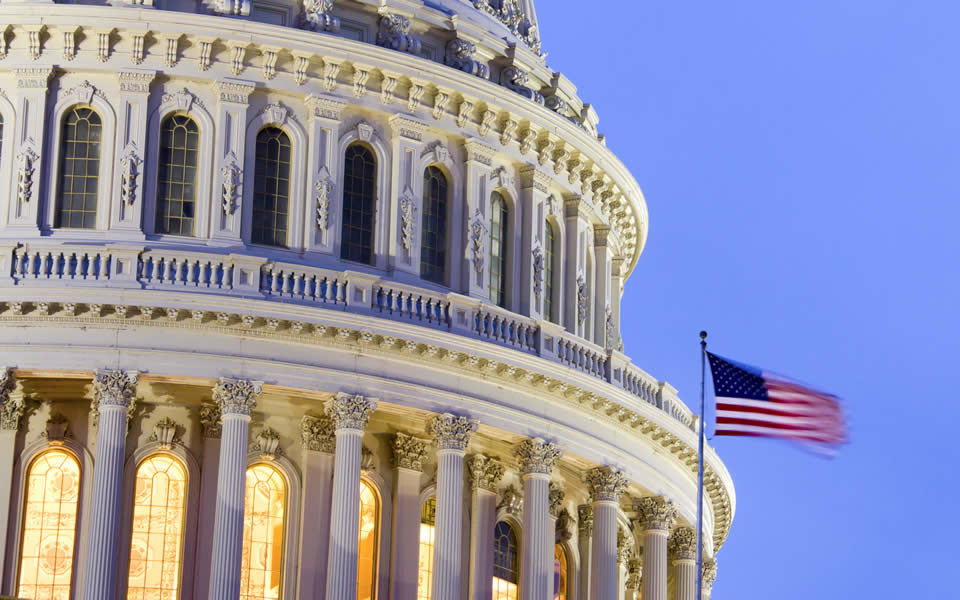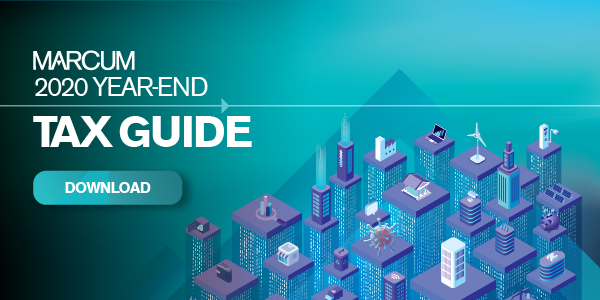COVID-19 Relief Bill Signed into Law with Tax Provisions
By Michael D’Addio, Principal, Tax & Business Services
The Consolidated Appropriation Act of 2021 was signed into law by the President on Sunday, December 27, 2020, containing the most recent COVID-19 relief provisions as well as many tax provisions.
Following is a summary of the individual and business tax provisions included in the proposed Act.
Individual Tax Changes
Additional Cash Stimulus Payments
- In addition to the original Economic Impact Payment, an eligible individual is allowed $600 for 2020 ($1200 for married joint filers) plus $600 for each qualifying child. (Note that children are eligible for the same benefit as adults.)
- Phase-out of stimulus payment eligibility commences at income levels of $75,000 for individuals $150,000 for married/ joint, and $112,500 for head of household.
- Eligible individual excludes: 1) nonresident alien individual; 2) one who is a dependent of another.
- Unlike the CARES Act, families with members of mixed immigration status with a valid Social Security number for one spouse are also eligible for the payments.
- Advance refund/credit will be based on the eligible individual’s 2019 income.
Child Tax Credit and Earned Income Tax Credit
The computations for these credits are adjusted. While they would generally be based on the 2020 tax year, the concern is that, as a result of the pandemic, 2020 earnings may be low (due to lower earnings, job loss, underemployment) and produce a reduced credit. The new law permits use of 2019 income to determine eligibility for the individual’s credit for the 2020 tax year. This rule will also prevent unemployment insurance benefits received in 2020 from reducing credits.
Charitable Contributions
- The above-the-line charitable contribution deduction is extended through 2021 at $600 for joint filers and $300 for others.
- For 2020 and 2021, the percentage limitation (normally 60% of Adjusted Gross Income or AGI) for qualified charitable contributions will not apply. This provision essentially extends the CARES Act 100% AGI contribution rule.
Flexible Savings Accounts (FSAs)
FSA balances can be rolled over from the 2020 tax year into 2021, and 2021 balances can be rolled into 2022. This provision helps taxpayers with unused balances (e.g., for childcare expenses) that would normally be lost at year-end.
Educator Expenses for Protective Equipment
Treasury is required to issue regulations or guidance so that the cost of personal protective equipment and other supplies for the prevention of COVID-19 spread are treated as eligible for the educator expense deduction. This rule will apply retroactively to March 12, 2020.
Emergency Financial Aid Grants
For a student receiving a Qualified Emergency Financial Aid Grant, the following applies:
- The grant is not included in income.
- The grant shall not be treated as reducing qualified tuition or related expenses so that the American Opportunity and Lifetime Learning Credits may be maximized.
Business Taxation
Payroll Protection Program Expenses Are Deductible
The law resolves the issue and reverses the Treasury position on the deductibility of expenses paid with PPP loan funds that are forgiven. Under the proposed new law, businesses can deduct expenses paid with forgiven PPP loans. The deductibility is without caps, guardrails, or limitations and applies to all taxpayers.
This confirms the intention of the law to create a two-part subsidy for tax-free income (on debt forgiveness) and deduction of costs. It should be noted that the Joint Committee on Taxation scored the original provision under the CARES Act on this basis. Since this is considered a technical correction, it does not have a budget impact.
This rule is effective for tax years ending after the date of the original CARES Act (March 26, 2020) and is, therefore, retroactive.
Other CARES Act Loan Forgiveness and Financial Assistance
The CARES Act provided for: 1) an emergency grant for an advance of $10,000 on an Economic Injury Disaster Loans (EIDL); and 2) loan repayment assistance for certain CARES Act loans.
The new law provides that gross income will not be increased due to loan forgiveness on these items. In addition, similar to the PPP loan rule above, expenses paid with such amounts are deductible and produce normal basis adjustments.
This rule is also retroactive to tax years ending after the date of the original CARES Act.
Deductibility of Business Meals
The deduction for business meals is increased from 50% to 100% for 2021 and 2022.
Farmer NOL carryback
Farmers who elected a 2-year NOL carryback prior to the CARES Act are allowed to continue a 2-year election instead of the 5-year carryback provided for under the CARES Act. Additionally, farmers who previously waived an election to carryback an NOL can revoke the waiver.
Depreciation of Certain Residential Rental Property
The Tax Cuts and Jobs Act permitted a real property trade or business to elect out of the business interest deduction rules of IRC section 163(j). The cost of the election is the requirement to use the ADR life for nonresidential real estate, residential real property and qualified improvement property.
For residential property placed in service after December 31, 2017, a 30-year life applies. However, for property placed in service before January 1, 2018, a 40-year life was required. The new law provides that a 30-year life applies even for the property placed in service prior to January 1, 2018.
Employer and Employee Payroll Tax Provisions
Elective Deferral of Employee Social Security Taxes – Extension of Payment Date
The President’s Executive Order permits employers to defer the payment of employee social security taxes on certain eligible salaries (bi-weekly salary less than $4,000) for the period September 1 through December 31, 2020. This new law extends the period for the payment of the deferred taxes from the original cut-off of April 30, 2021.
Payroll Tax Credits
The new law extends refundable payroll tax credits for paid sick and emergency medical family leave, which expire December 31, 2020, through the end of March 2021.
The law provides a comparable benefit for self-employed persons. It permits an election for self-employed individuals to use average daily self-employment income from 2019 in computing the credit.
Employee Retention Tax Credit
This credit has been extended to June 20, 2021, and has been significantly modified.
- The computation of the refundable payroll tax credit is adjusted for calendar quarters beginning after December 31, 2020, so that:
- It applies to per-employee eligible wages of $10,000 per quarter (versus $10,000 per year).
- There is an increase in the credit rate from 50% (for a maximum $5,000 credit for the year) to 70% of wages (for up to $7,000 per quarter per eligible employee).
- A substantial reduction of gross income is now defined as a 20% reduction and not a 50% reduction.
- A safe harbor is created so that an employer can use prior-quarter gross receipts in determining eligibility.
- In determining wages eligible for the credit, the demarcation point is increased from 100 employees to 500 employees.
- New employers that were not in existence for all or part of the 2019 year are permitted to receive the credit.
Certain changes to the Employee Retention Tax Credit were made retroactive to the effective date of the CARES Act in March 2020:
- Employers who received PPP loans (and were not eligible for the credit under the original law) may be able to qualify for the credit with respect to wages not paid with forgiven PPP proceeds. The law permits an employer to elect to treat certain amounts paid as not being qualified wages.
- The Employee Retention Tax Credit now conforms with the current IRS position that group health plan costs can be included in qualified wages despite the fact that the employee has no other wages (e.g., where the employee has been furloughed).
- Provides guidance on the qualification of tax-exempt organizations, including the rules for determining a reduction of gross receipts.
- Since employers may have already filed a return for employment taxes prior to the date of enactment of this law, the law provides that an election can be made (per Treasury guidance to be issued in the near future) to treat an applicable amount as an amount paid in the calendar quarter that includes the enactment of this Act.
Extenders
In addition to COVID relief, the legislation contains a number of tax extender provisions.
Sec 179D Energy Efficient Commercial Building Deduction
This provision (which was scheduled to expire 2020) has been made permanent. Under this section of the Tax Code, a taxpayer is able to claim a deduction for energy efficient improvements to lighting, heating, cooling, ventilation and hot water systems of commercial real property. The deduction is based on $1.80 per square foot. However a $.60 deduction is permitted where certain subsystems meet standards if the entire building does not.
The new law adjusts the $1.80 rate based on an inflation factor after 2020, using 2019 as the base year.
Qualified Tuition and Related Expenses
The new law removes the different phase-out rules for the American Opportunity Tax Credit and the Lifetime Learning Credit. For 2021 and later, a single phase-out is created.
The deduction for higher education expenses is repealed for tax years after 2020.
New Markets Tax Credit
The $5 billion allocation of available credits is extended for 2021 through 2025.
Work Opportunity Credit
The program providing a credit for employers hiring individuals covered by 10 targeted groups is extended through 2025.
Principal Residence Indebtedness Discharge
The prior law rule excluding from gross income debt discharge on qualified principal residence debt of up to $2 million ($1 million for a married filing separate filer) was scheduled to terminate after 2020 (though it would be applicable under a binding contract exception).
The new law extends the exclusion for discharges between 2021 and 2025. However, the maximum exclusion amount is significantly reduced to $750,000 ($375,000 for married separate filers).
Mortgage Insurance Premiums Treated as Qualified Resident Interest
This provision treating mortgage insurance premiums related to acquisition indebtedness for a principal residence as an interest expenses (subject to phase out rules based on AGI) is extended through 2021.
Empowerment Zone Tax Incentives
These are extended through December 31, 2025, for the period that the designation of an empowerment zone is in effect.
Exclusion for Employer Payment of Student Loans
Payment pertaining to a qualified educational assistance program, up to $5,250, will be treated as a nontaxable benefit and is extended for payments through 2025.
Employer Paid Family and Medical leave Program
The Code extends to an employer that provides paid family and medical leave a credit of 12.5% of eligible wages, where the rate of payment is 50% of wages, increased by .25% for each percentage point above 50% of wages paid for a maximum 12-week period. This program was intended to terminate after the 2020 tax year. The new law would extend this credit through 2025.
For questions, please contact your Marcum professional or Michael D’Addio at (203) 781-9665 or email Michael.
Coronavirus Resource Center
Have more questions about the impact of the coronavirus on your business? Visit Marcum’s Coronavirus Resource Center for up-to-date information.







